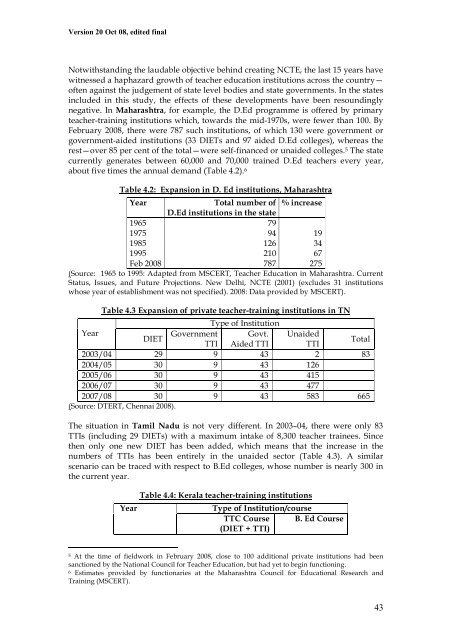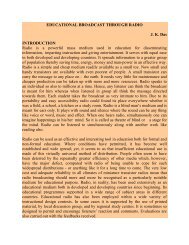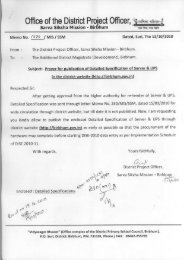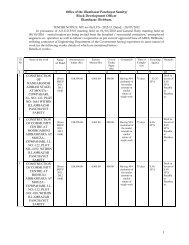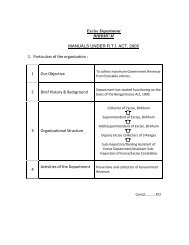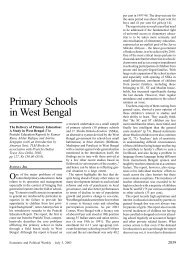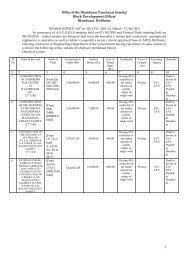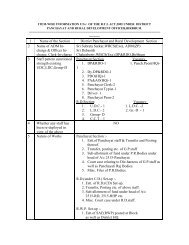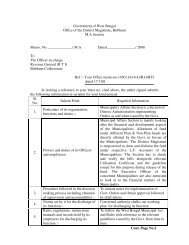primary school teachers the twists and turns of ... - ERU Consultants
primary school teachers the twists and turns of ... - ERU Consultants
primary school teachers the twists and turns of ... - ERU Consultants
Create successful ePaper yourself
Turn your PDF publications into a flip-book with our unique Google optimized e-Paper software.
Version 20 Oct 08, edited finalNotwithst<strong>and</strong>ing <strong>the</strong> laudable objective behind creating NCTE, <strong>the</strong> last 15 years havewitnessed a haphazard growth <strong>of</strong> teacher education institutions across <strong>the</strong> country—<strong>of</strong>ten against <strong>the</strong> judgement <strong>of</strong> state level bodies <strong>and</strong> state governments. In <strong>the</strong> statesincluded in this study, <strong>the</strong> effects <strong>of</strong> <strong>the</strong>se developments have been resoundinglynegative. In Maharashtra, for example, <strong>the</strong> D.Ed programme is <strong>of</strong>fered by <strong>primary</strong>teacher-training institutions which, towards <strong>the</strong> mid-1970s, were fewer than 100. ByFebruary 2008, <strong>the</strong>re were 787 such institutions, <strong>of</strong> which 130 were government orgovernment-aided institutions (33 DIETs <strong>and</strong> 97 aided D.Ed colleges), whereas <strong>the</strong>rest—over 85 per cent <strong>of</strong> <strong>the</strong> total—were self-financed or unaided colleges. 5 The statecurrently generates between 60,000 <strong>and</strong> 70,000 trained D.Ed <strong>teachers</strong> every year,about five times <strong>the</strong> annual dem<strong>and</strong> (Table 4.2). 6Table 4.2: Expansion in D. Ed institutions, MaharashtraYearTotal number <strong>of</strong> % increaseD.Ed institutions in <strong>the</strong> state1965 791975 94 191985 126 341995 210 67Feb 2008 787 275(Source: 1965 to 1995: Adapted from MSCERT, Teacher Education in Maharashtra. CurrentStatus, Issues, <strong>and</strong> Future Projections. New Delhi, NCTE (2001) (excludes 31 institutionswhose year <strong>of</strong> establishment was not specified). 2008: Data provided by MSCERT).Table 4.3 Expansion <strong>of</strong> private teacher-training institutions in TNType <strong>of</strong> InstitutionYearGovernment Govt. UnaidedDIETTTI Aided TTI TTITotal2003/04 29 9 43 2 832004/05 30 9 43 1262005/06 30 9 43 4152006/07 30 9 43 4772007/08 30 9 43 583 665(Source: DTERT, Chennai 2008).The situation in Tamil Nadu is not very different. In 2003–04, <strong>the</strong>re were only 83TTIs (including 29 DIETs) with a maximum intake <strong>of</strong> 8,300 teacher trainees. Since<strong>the</strong>n only one new DIET has been added, which means that <strong>the</strong> increase in <strong>the</strong>numbers <strong>of</strong> TTIs has been entirely in <strong>the</strong> unaided sector (Table 4.3). A similarscenario can be traced with respect to B.Ed colleges, whose number is nearly 300 in<strong>the</strong> current year.YearTable 4.4: Kerala teacher-training institutionsType <strong>of</strong> Institution/courseTTC Course B. Ed Course(DIET + TTI)5 At <strong>the</strong> time <strong>of</strong> fieldwork in February 2008, close to 100 additional private institutions had beensanctioned by <strong>the</strong> National Council for Teacher Education, but had yet to begin functioning.6 Estimates provided by functionaries at <strong>the</strong> Maharashtra Council for Educational Research <strong>and</strong>Training (MSCERT).43


